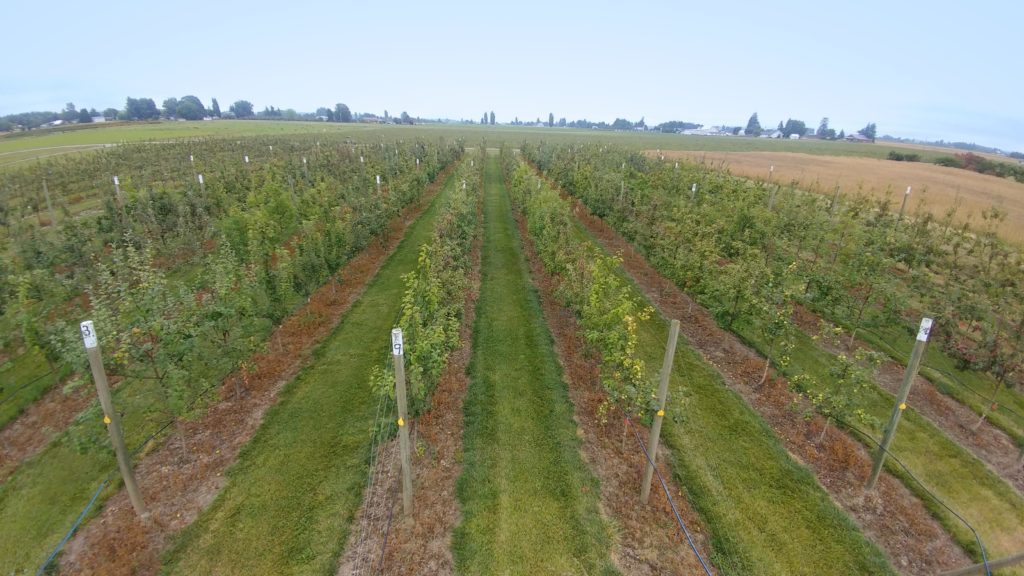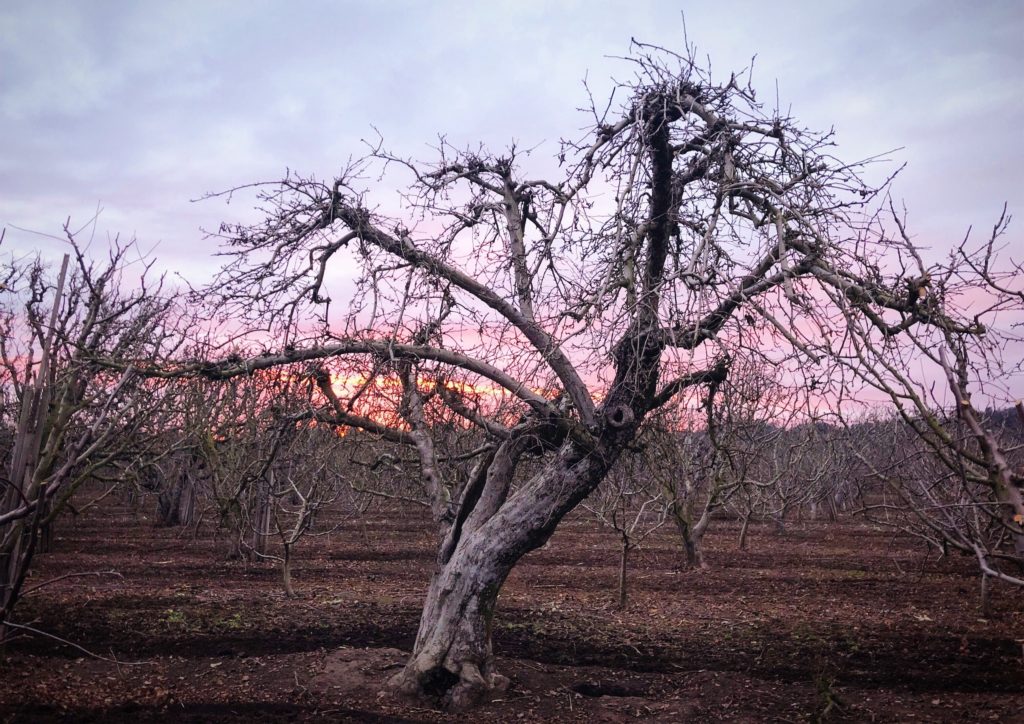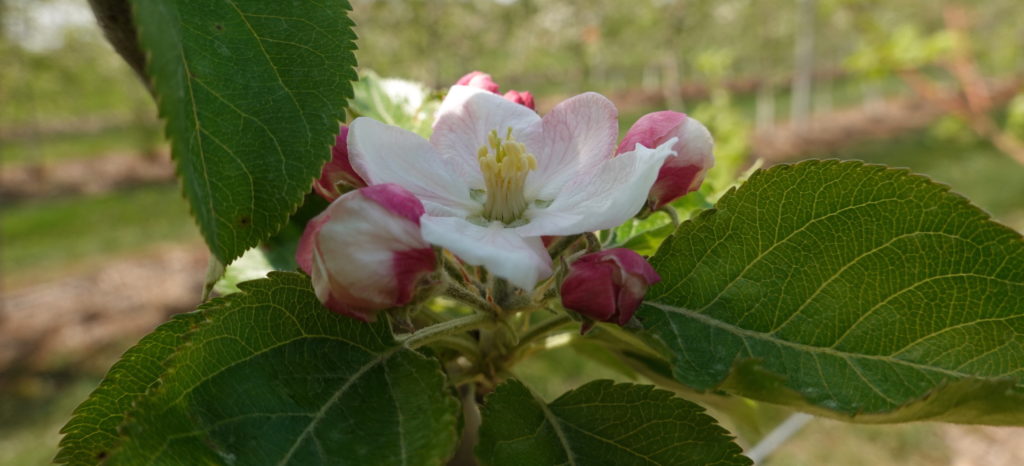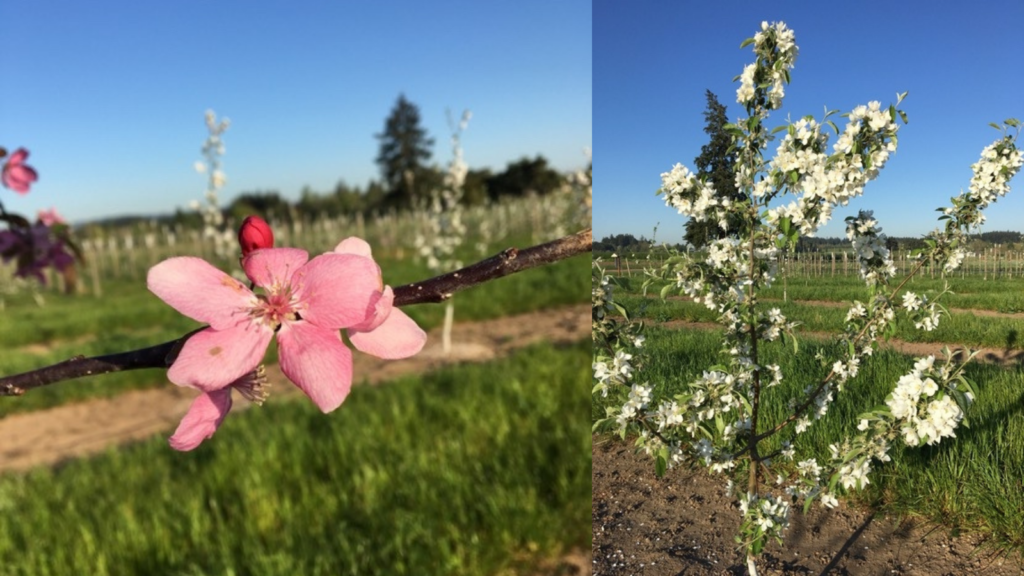2021 Apple Crop Outlook
We reached out to extension agents and orchardists around the country to hear what they had to say about the progression of the 2021 apple crop around the United States. Here’s what they had to say.
Aidan Kendall, Mt. Vernon Northwest Washington Research and Extension Center, Mt. Vernon, WA
The cider apple research orchard at WSU NWREC consists of 65 different cultivars grafted onto Geneva 935 rootstock, and 4 cultivars grafted onto Geneva 202. Our apples are being managed with a conventional pesticide rotation. Apple anthracnose is present, though largely kept under control with the removal of contaminated wood. This year many of our cultivars are bearing little to no fruit as a result of a heavy crop in 2020, though what flowered was pollinated successfully by a new on-site hive. The heat wave brought sunburn to some cultivars with heavily exposed fruit, mostly in the border rows. We are grateful for healthy trees and as always, excited for this year’s harvest.

Jake Mann, The Five Mile Orchard, Pajaro Valley, CA
The 2020 harvest came on quickly after the heatwaves of August ripened the apples faster than expected. Our crews were helpful in sorting out sunburnt fruit while picking, and the sound crop stored well in our coolers. Wildfire smoke was an added challenge to harvest logistics, ending some picking days early even though the N95 masks provided by our County Agricultural Commissioner were very helpful to all involved. Apples do not pick up smoke taint, and so we were able to avoid the moral and financial quandary that the wine industry faces in these events. We simply wait until the next reasonable day to continue picking.
It was a dry winter. Pruning work was completed quickly in December and January thanks to no weather delays. Dormant sprays went on without difficulty. We received the most chilling hours seen here in 25-30 years… between 600 and 800, much more than needed to reset our trees. The bloom looked good, and there were no rain events during that time (and so, minimal apple scab events necessitating fungicide sprays beyond our regular applications) As we moved into May, it became apparent that fruit set was light across the Pajaro Valley. Looking back on cold days during bloom, a couple localized morning hail storms, and the possibility of a down year in what remains of a biennial bearing cycle (after 3 good harvests in 2018/2019/2020) has all the growers speculating about what happened, how harvest plans and crop projections will be adjusted. Some of our bonus varieties like Jonagold and Granny Smith (usually reliable croppers) are very light this year. Most of our Newtown Pippin blocks have an acceptable crop developing, and the Red Delicious and Fujis are looking decent enough to sustain a picking crew through harvest.
California is now in another historic drought and we are upping our irrigation plan for this season. We operate with temporary installations of 6″ mainline and 3″ sprinkler pipe, hooking up to shared wells as they’re available through a given week. Usually only applied once in July, we opted for an additional, early round in May that has given the crop a helpful boost going into the big growing days of summer.
Orchard work happens outside, and the folks in our crew remained healthy during the pandemic, save for one core personality, Don Pablo, who passed in January after battling COVID in the hospital for a month. His loss was a real blow to the spirit of the extended family who works to keep these local orchards rolling year after year. The mobilization by our County to get vaccines specifically to the agricultural community in February and March was such a relief, and recognition of support, for the hard working people in our corner of the State.
I’m thankful for the apples we have growing, on ranches that’ve been under our care for years, showing the wisdom and skill of our team, and diligent, iterative improvements to the process year after year as we work with this 100+ year old system. Always something new to adapt to and improve upon. Our connections with the cider industry continue to grow, and it’s a real high point in my year to see how the fruit we produce is being elevated to such a nuanced, geographically representative, and historically significant beverage by the talented cider makers we have the fortune of working with here on the West Coast.

Greg Peck, Cornell University, Ithaca, NY
Crop conditions in Central NY look very good for most of the cider apple orchards. An early budbreak led to quite a bit of anxiety that we’d lose the entire crop to spring frosts. Luckily, the late blooming European cider varieties dodged the worst of the frosts and trees that are in their “on-year” were able to set a full crop. We’ve gotten plenty of rainfall in Central New York, so as we enter into July the fruit is sizing up quickly. Fireblight continues to be a major concern for cider apple orchards in NY. At our research farm in Ithaca, we had a bit of new infection through this year’s flowers despite a very aggressive anti-biotic spray program. We are also seeing fireblight show up in trees that were infected last year when we had a severe outbreak. We’ve applied pro-hexadoine three times this year, as well as adding a low rate of copper to our cover sprays. We also prune out symptomatic branches and sometimes whole trees at least once a week. The late blooming cider apple varieties might avoid spring frost damage, but they are extremely susceptible to fire blight infections during those warm and rainy spring days.
Megan Muehlbauer, Rutgers University, Snyder Research and Extension Farm in Pittstown, New Jersey
The weather in New Jersey was favorable in the spring for adequate pollination of apple flowers. Thus far the crop loads are looking good. Some thinning was required for a few varieties that had excessive fruit set.
In orchards where regular spray schedules were followed there was minimal disease pressure. This was due in part to the fairly dry weather observed in New Jersey from early spring up until present. Insect pressure has been light with the exception of the severe cicada brood X damage. Cicadas have been particularly destructive in the central portion of the state. They first emerged at the beginning of June and the populations are only just beginning to dwindle. Significant flagging of young shoots of apple trees can be seen in orchards throughout the state.

Elizabeth Garofalo, UMass Extension Fruit Program, Belchertown, MA
“Abnormally dry” conditions set in in MA on March 9, according to the U.S. Drought Monitor. These conditions persisted, reaching their worst during the week of April 27 when 20% of the state was experiencing “moderate drought” conditions. At the UMass Cold Spring Orchard in Belchertown, MA water deficits began to improve when a three-day event dropped ~2” of rain. While drought conditions in Belchertown have since abated, the site continues to receive below historical average amounts of rain as of July 1, 2021.
Temperatures in Belchertown during spring months (March-May) were overall warmer than average. On March 12, temperatures reached record highs and four days later, temperatures plummeted reaching record lows. In addition to abnormal, and wildly fluctuating, temperature patterns, nearly a foot of snow fell at Cold Spring Orchard on April 16.
With a drought on through much of the spring, you’d think that disease management would be a breeze. And when it comes to apple scab, you’d be right. With the exception of a few locations which had some extenuating circumstances, the primary scab season was managed readily. In fact, RIMpro logged only four primary infection events for the season (4/29, 5/4, 5/27 & 5/30). The severity of each event was estimated to be in the extreme, however and growers still had to be on their guard.
Long stretches of dry weather in early spring can often indicate an opportunity for reduced fungicide application. This may have been one cause of an increase in powdery mildew (PM) infections seen broadly across the state this year. Many growers have spent more time cutting out PM infested shoots than they did fireblight… Well, until recently that is. Fireblight during bloom was of relatively low concern in Belchertown (we all know fireblight is never of no concern!). Temperatures around bloom remained relatively cool. In fact there was some concern around pollination due to unfavorable bee conditions. However, as UMass’ Jon Clements reported, this year was “as close to a snowball bloom across the board as I have seen in awhile”. We managed to make it through with good fruit set and even squeaked out decent thinning weather although it was touch and go for a little while.
While blossom (fire)blight was not seen much, shoot blights began to show up in late June. Typically, we see this phase manifest later, in early to mid- July. Which, in the timeline of this season brings me too today. As I look out my window, all I can think is “Ouch, bitter rot must be having a field day out there right now”. Climatic conditions for infection initiation are ripe for bitter rot development. We will be keeping a close watch out there for this disease. Over the last few years, we have seen bitter rot cropping up more and more, even though in the past we have traditionally thought of it as a “southern disease”.
While insects aren’t my forte, per se, I can tell you this: we have seen more rosy apple aphid outbreaks across MA this year than we have in recent past. Unfortunately, once you have observed the characteristic leaf curl, it is too late to make an effective insecticide application. We expect to see more deformed, stunted fruit at harvest this year than usual, although, hopefully, not too much. Another interesting if unsettling development in the world of crawlies this year is the early capture of brown marmorated stink bug (BMSB). Typically, in MA, we do not catch this pest in our traps until later in the summer. This year our resident entomologist Dr. Jaime Piñero and his team of graduate students observed the first BMSB in traps the week of May 24 in 5 of 13 locations where traps were set out with a high count of 14.
It seems our warmer than average seasonal temperatures are making certain insect and pathogen pests happy, while vexing us.
Update: As of August 4, Belchertown, MA has exceeded average annual precipitation by more than 3” and Greenfield MA has seen more than 6” above annual average precipitation. If we continue to experience above average rainfall, sugar concentrations in apples could decline.
Amy Dunbar-Wallis, Boulder Apple Tree Project, Boulder, Colorado
After two very disappointing apple-yield years in Boulder County, Colorado, the 2021 crop is looking promising. In 2020, a late frost and snow impacted budburst and pollination so we had very few apples. This year, we have experienced higher than average precipitation with relatively mild temperatures. Undergraduate students involved with the Boulder Apple Tree Project have reported trees with many small apples forming throughout the canopy while out mapping historic trees. Fire blight and codling moths continue to be an issue for apple tree growers. We are optimistic that this will be an excellent year for apple yield.
Nik Wiman, Oregon State University, Corvallis, Oregon
We are in a severe drought here in the Willamette Valley. Regardless, our apple crop in the cider orchard is really great this year. We were a bit overcropped as the fruit set was very high. We have been thinning aggressively because our trees can’t support the fruit load yet. We had an unusual dry spring, so we are anticipating low disease pressure from apple scab, which can be pretty ferocious here in a normal year. Codling moth pressure is always high, and we are anticipating lots of pressure from borers, both flatheaded borers, which thrive on drought-stressed trees, and ambrosia beetles which seem to be ever-present. We hope the heat will not negatively impact fruit quality. We should have fruit available for purchase this year, and we are hoping to have an open-house at our cider orchard this year.

Thomas Kon, NC State Mountain Horticultural Crops Research and Extension Center, Mills River, North Carolina
Spring 2021 was not kind to southeastern apple growers (NC, SC, and GA). A pair of cold nights at pink bud stage caused some bud mortality, which resulted in a reduction in crop potential at some locations. When at petal fall, we observed 25 to 26 F at several locations, and many sites were below freezing for multiple hours. The result is widespread and significant crop damage/loss, with a few exceptions. Unfortunately, 2021 will be a difficult year for much of the southeastern apple industry.
Nikki Rothwell, MSU Extension, Traverse City, Michigan
We have a good crop of apples in NW Michigan. The crop is a bit lighter in our main apple growing region on the Ridge (just north of Grand Rapids). We have had some issues with fire blight this season, and I have also seen more scab than I would like to see so early in the season. The NW region of the state had some bad hail, but as always with hail, it is isolated–some orchards got lucky while others did not. The insect front has been slow with the cool weather early followed by the super hot, but I suscept with the rains, they will start to become more of an issue. Some areas of MIchigan received over 6″ of rain on the 24-28 June rain event. This humidity and wet conditions will also foster disease development if growers did not control primary scab.
Katrina Mendrey, Western Agricultural Research Center, Corvallis, Montana
The fall of 2020 has had a huge impact on cider apple production in the Intermountain West with several cultivars, in particular when trees are under five years, being severely damaged or killed by a sudden drop in temperatures in late October. Some of the cultivars that were severely damaged include Dabinette, Chisel Jersey, Roxbury Russet, Golden Russet and Ashmaed’s Kernel. The degree of damage was variable though based on location and the age of trees and a full report can be found here. For cultivars that came out of the winter undamaged, including Hewe’s Virginia Crab, Binet Rouge, Tom Putt, Muscadtte de Dieppe and Wickson, we’ve had good pollination and fruit set. Fire blight danger was high throughout bloom as usual. Whether trees made it through the high risk period uninfected largely will depend on grower control with effective sprays. So far we haven’t had any reports of damage and have been scouting several orchards for samples to include in a research study on antibiotic resistance in Montana fire blight.
Sherif M Sherif, AHS Jr. Agricultural Research and Extension Center, Winchester, Virginia
Our digital temperature data loggers placed in four different blocks in the AHS Jr. AREC’s research farm, Winchester, VA indicated that we were hit by killing freezing temperatures in the mornings of Friday (April 2) and Saturday (April 3), with the latter being more aggressive and long-lasting. In fact, the lowest we received on Friday was 24oF, but on Saturday, our trees were hammered by temps as low as 21oF for more than 30 min. 21 oF for 30 min or more are enough to kill 90% of apple flower buds at ‘tight cluster’, ‘first pink’ and ‘full pink’. On April 5, we collected flower clusters from Gala, Fuji, Pink Lady, Red Delicious, Zester, and Honeycrisp. Except for Zester, all the cultivars were only moving from ‘tight cluster’ to ‘first pink’. Zestar with flowers at ‘full pink’ showed 65% mortality. Other cultivars showed 45% (Fuji), 45% (Gala), 42% (Pink Lady), 15% (Red Delicious) and 5% (Honeycrisp). Unsurprisingly, king blossoms showed far more damage than side flowers. That being said, I would say that most Virginia growers, especially those in northern and central parts of the state, will achieve almost full-crop at harvest for apples. Growers insouthwest Virginia indicated that their apple orchards were hit hard by frost and they don’t expect an economic crop this year.

Photos from VA Tech AHS Jr. Agricultural Research and Extension Center
Renae Moran, University of Maine Highmoor Farm, Monmouth, Maine
Spring 2021 weather conditions were favorable for a heavy fruit set. Freezes occurred when trees were still at half-inch-green or tight cluster, so Maine has not had any cold temperature damage as far as I know. Some regions of the state had a very light crop last year and may be set up for biennial bearing, but hopefully, I am wrong. We had abundant bloom and good pollination, so we could be in for an excessive crop. As of May 26, most growers have applied a chemical thinner with favorable weather for good effectiveness. Last year, several growers in the southern part of the state had fireblight outbreaks, and late blooming cider varieties were particularly hard hit. As we progress through the fruit set stage, the lack of sufficient rainfall has many of us worried about another prolonged drought, but it could lessen the chance for more fireblight. Best of luck this season to all apple growers.


This crop load analysis blog post is highly informative. Thanks everyone for sharing.
What a great resource. Thank you!